Available Resources on Cr(VI)
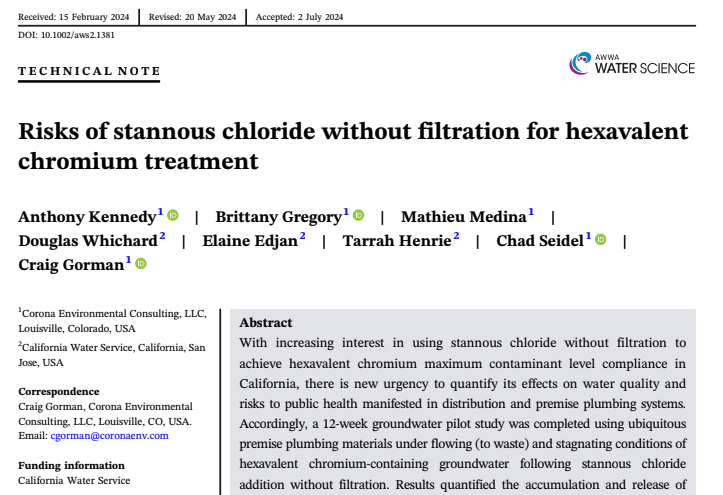
Abstract
With increasing interest in using stannous chloride without filtration to achieve hexavalent chromium maximum contaminant level compliance in California, there is new urgency to quantify its effects on water quality and risks to public health manifested in distribution and premise plumbing systems. Accordingly, a 12-week groundwater pilot study was completed using ubiquitous premise plumbing materials under flowing (to waste) and stagnating conditions of hexavalent chromium-containing groundwater following stannous chloride addition without filtration. Results quantified the accumulation and release of chromium and tin, with total chromium concentrations exceeding regulatory or acceptable levels under stagnating conditions. Sediment with elevated chromium, tin, arsenic, and manganese concentrations was also observed. Given these obser- vations would likely occur and worsen over time in distribution systems that cumulatively serve large populations, the use of stannous chloride without filtra- tion represents an unacceptable risk to public health compared to other, more well-established, best available technologies.
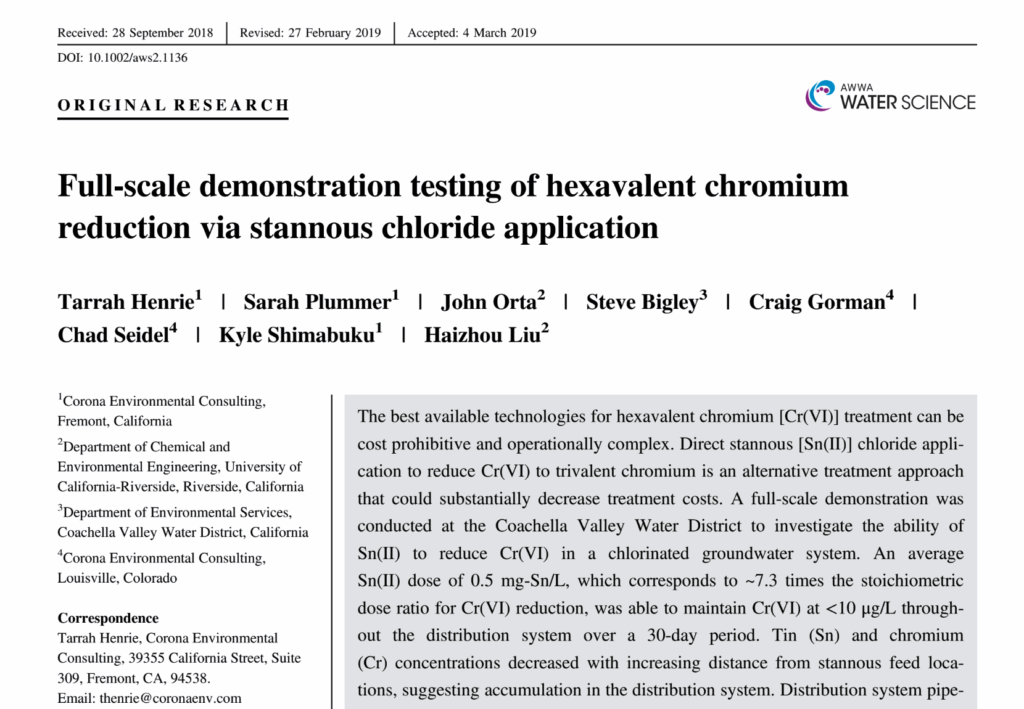
Abstract
The best available technologies for hexavalent chromium [Cr(VI)] treatment can be cost prohibitive and operationally complex. Direct stannous [Sn(II)] chloride appli cation to reduce Cr(VI) to trivalent chromium is an alternative treatment approach that could substantially decrease treatment costs. A full-scale demonstration was conducted at the Coachella Valley Water District to investigate the ability of Sn(II) to reduce Cr(VI) in a chlorinated groundwater system. An average Sn(II) dose of 0.5 mg-Sn/L, which corresponds to ~7.3 times the stoichiometric dose ratio for Cr(VI) reduction, was able to maintain Cr(VI) at <10 μg/L through- out the distribution system over a 30-day period. Tin (Sn) and chromium (Cr) concentrations decreased with increasing distance from stannous feed loca- tions, suggesting accumulation in the distribution system. Distribution system pipe- scale analysis after the demonstration found the presence of Sn and Cr in pipe scales; however, minimal Sn and Cr release was observed during main flushing at the end of the demonstration.
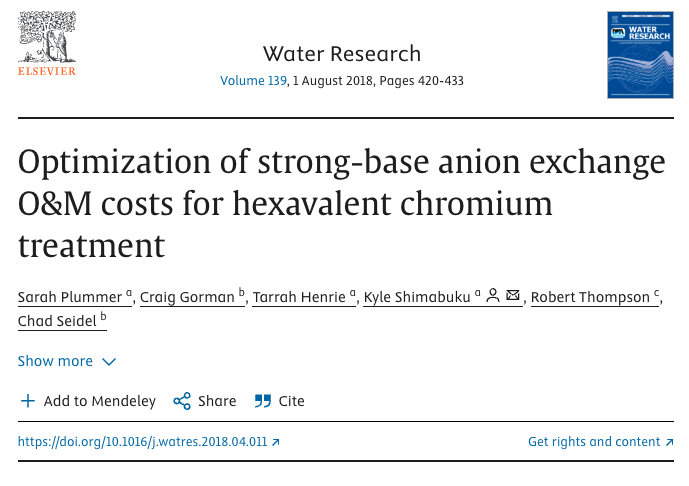
Abstract
Hexavalent chromium [Cr(VI)] in drinking water is pending regulation in California and is being considered for regulation in other locations. While strong-base anion exchange (SBA-IX) can efficiently remove Cr(VI) to low-levels that may be required to comply with future MCLs, operational and maintenance (O&M) costs can be considerable if the spent brine is disposed of as hazardous waste. Through bench- and pilot-scale experiments and full-scale demonstrations, this study examined the ability of emerging and established brine treatment and reuse techniques as well as recently developed resins to decrease O&M costs.
When profiling anion elution during regeneration with nanofiltration treated and untreated spent brine, it appeared that at least 1 and 3 reuse cycles were feasible, respectively. Stannous- and ferrous-based reductants were more efficient than sulfur-based reductants when treating spent brine. Bed volumes to 8 μg/L chromium breakthrough with 7 resins varied by as much as a factor of 2 and correlated (R2 = 0.84) with resin total exchange capacities. Spent brine reuse, segmented regeneration (an optimized brine reuse method), ferrous reduction, and nanofiltration of spent brine were estimated to decrease O&M costs by 30, 70, 63, and 61%, respectively. Selection of high performing resins was the most simple way to decrease O&M costs (up to 70% savings). The sum of nitrate and sulfate raw water equivalent concentrations was found to be the principal water quality parameter that influenced the performance of 4 resins in 7 different groundwaters because nitrate and sulfate concentrations were orders of magnitude greater than chromium concentrations. Resins with higher chromium capacities eluted more co-contaminants including arsenic, selenium, uranium, and vanadium because they likely had higher co-contaminant capacities. Co-contaminant elution was found to be complex because associations can form between regenerant and co-eluting anions. Sodium chloride was the most efficient regenerant, though other regenerants provided benefits such as enhanced uranium elution most likely by complexing with uranium to inhibit its precipitation. Nitrate peaking was found to be limited even when reusing untreated and nanofiltration treated spent brine.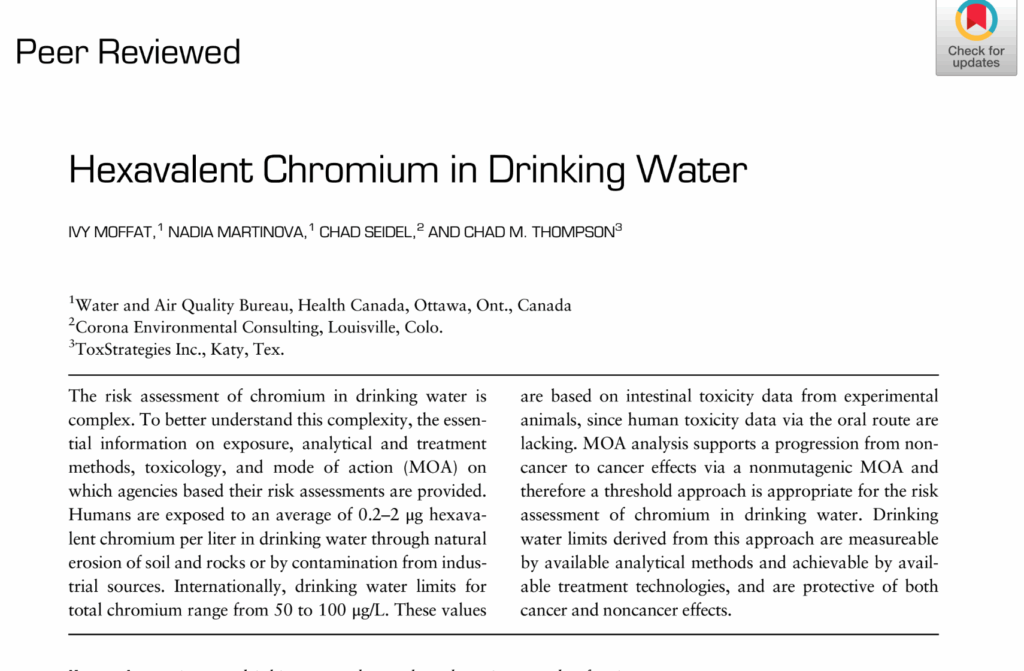
Abstract
The risk assessment of chromium in drinking water is complex. To better understand this complexity, the essen- tial information on exposure, analytical and treatment methods, toxicology, and mode of action (MOA) on which agencies based their risk assessments are provided. Humans are exposed to an average of 0.2–2 μg hexava- lent chromium per liter in drinking water through natural erosion of soil and rocks or by contamination from indus- trial sources. Internationally, drinking water limits for total chromium range from 50 to 100 μg/L. These values are based on intestinal toxicity data from experimental animals, since human toxicity data via the oral route are lacking. MOA analysis supports a progression from non- cancer to cancer effects via a nonmutagenic MOA and therefore a threshold approach is appropriate for the risk assessment of chromium in drinking water. Drinking water limits derived from this approach are measureable by available analytical methods and achievable by avail- able treatment technologies, and are protective of both cancer and noncancer effects.
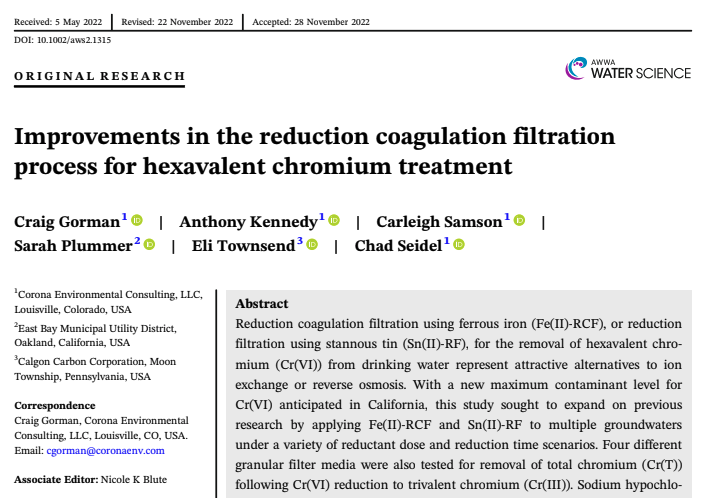
Abstract
Reduction coagulation filtration using ferrous iron (Fe(II)-RCF), or reduction filtration using stannous tin (Sn(II)-RF), for the removal of hexavalent chro- mium (Cr(VI)) from drinking water represent attractive alternatives to ion exchange or reverse osmosis. With a new maximum contaminant level for Cr(VI) anticipated in California, this study sought to expand on previous research by applying Fe(II)-RCF and Sn(II)-RF to multiple groundwaters under a variety of reductant dose and reduction time scenarios. Four different granular filter media were also tested for removal of total chromium (Cr(T)) following Cr(VI) reduction to trivalent chromium (Cr(III)). Sodium hypochlo- rite, instead of aeration, was used to oxidize excess Fe(II) to Fe(III) prior to fil- tration, with minimal Cr(III) to Cr(VI) reoxidation. Sn(II)-RF was also able to achieve Cr(T) and Cr(VI) treatment goals without dedicated reduction time prior to filtration. Results of this study were used to develop more up-to-date, feasibility-level, 20-year annualized cost estimates.
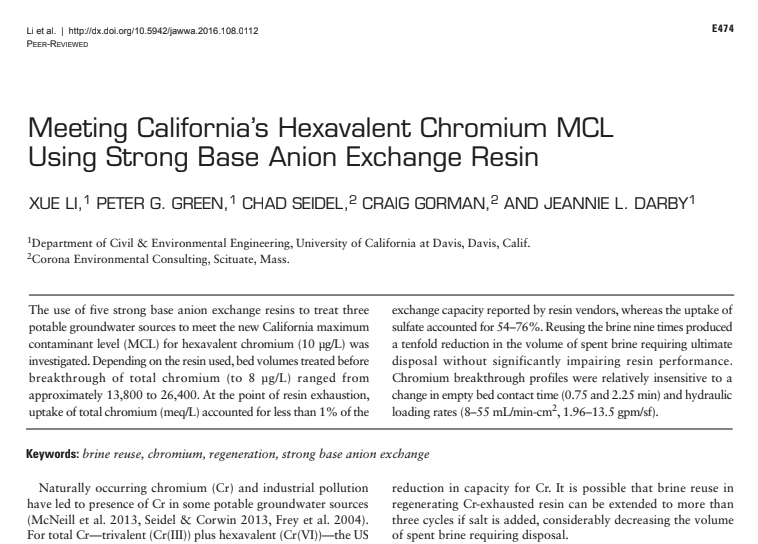
Abstract
California, the first state in the nation to regulate hexavalent chromium (CrVI) in drinking water, has set a maximum contaminant level (MCL) of 10 μg/L. To comply with the MCL, a California utility conducted extensive pilot studies to determine the best- performing ion exchange resin, empty bed contact time (EBCT), and hydraulic loading rate (HLR). The CrVI removal capacities of four strong base anion exchange resins were tested at seven wells.
Results showed that between 12,000 and 37,000 bed volumes of treatment can be expected before an 8-μg/L breakthrough threshold. HLR was shown to have little effect on CrVI removal within the range tested (7.5 to 30 gpm/ft2), whereas longer EBCTs (>45 s) appeared to improve performance. The presence of co-occurring anions in the raw water—namely, sulfate and nitrate—had substantial effect on the resin’s chromium loading capacity.
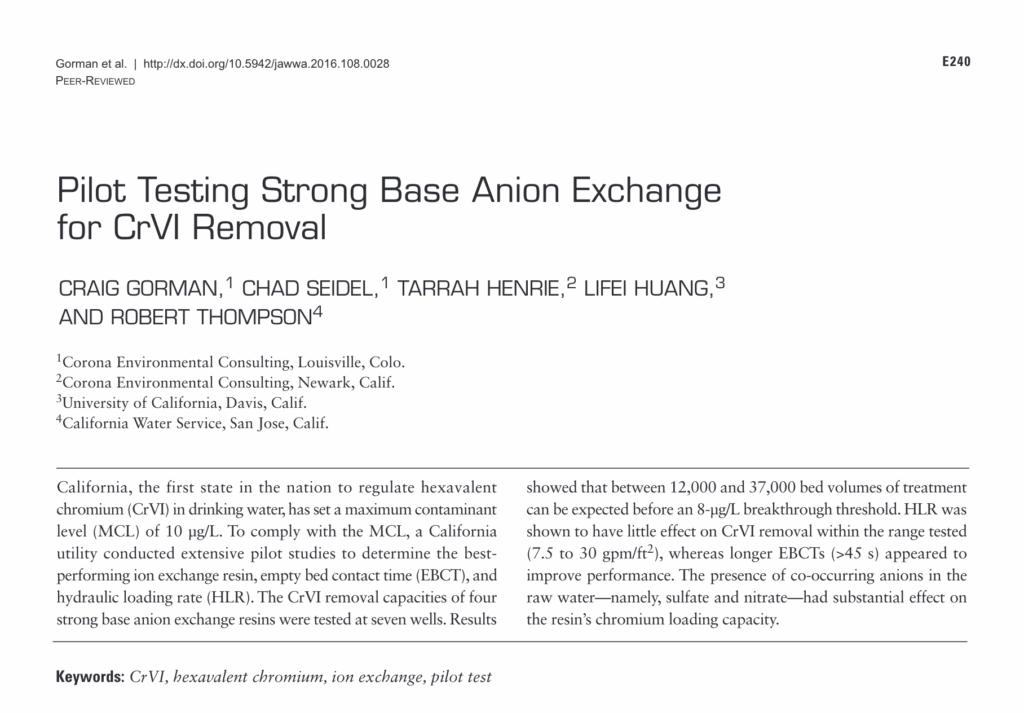
Abstract
The use of five strong base anion exchange resins to treat three potable groundwater sources to meet the new California maximum contaminant level (MCL) for hexavalent chromium (10 μg/L) was investigated. Depending on the resin used, bed volumes treated before breakthrough of total chromium (to 8 μg/L) ranged from approximately 13,800 to 26,400. At the point of resin exhaustion, uptake of total chromium (meq/L) accounted for less than 1% of the exchange capacity reported by resin vendors, whereas the uptake of sulfate accounted for 54–76%. Reusing the brine nine times produced a tenfold reduction in the volume of spent brine requiring ultimate disposal without significantly impairing resin performance. Chromium breakthrough profiles were relatively insensitive to a change in empty bed contact time (0.75 and 2.25 min) and hydraulic loading rates (8–55 mL/min-cm2, 1.96–13.5 gpm/sf).
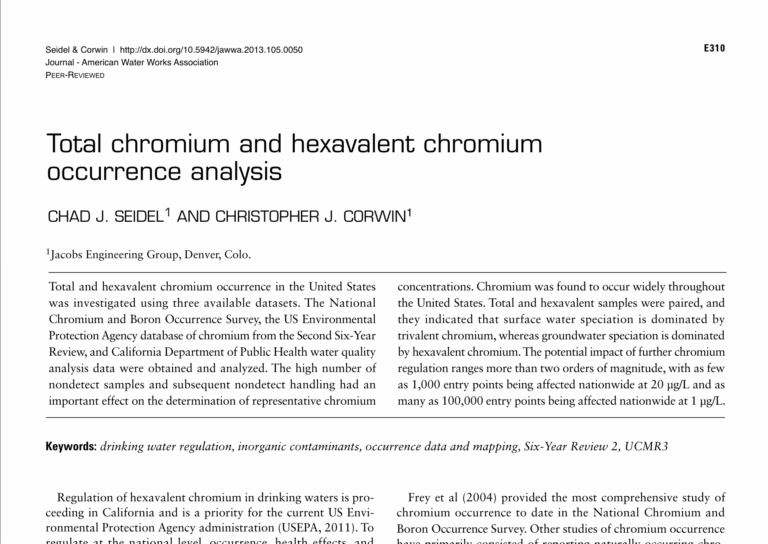
Abstract
Total and hexavalent chromium occurrence in the United States was investigated using three available datasets. The National Chromium and Boron Occurrence Survey, the US Environmental Protection Agency database of chromium from the Second Six-Year Review, and California Department of Public Health water quality analysis data were obtained and analyzed. The high number of nondetect samples and subsequent nondetect handling had an important effect on the determination of representative chromium concentrations. Chromium was found to occur widely throughout the United States. Total and hexavalent samples were paired, and they indicated that surface water speciation is dominated by trivalent chromium, whereas groundwater speciation is dominated by hexavalent chromium. The potential impact of further chromium regulation ranges more than two orders of magnitude, with as few as 1,000 entry points being affected nationwide at 20 μg/L and as many as 100,000 entry points being affected nationwide at 1 μg/L.
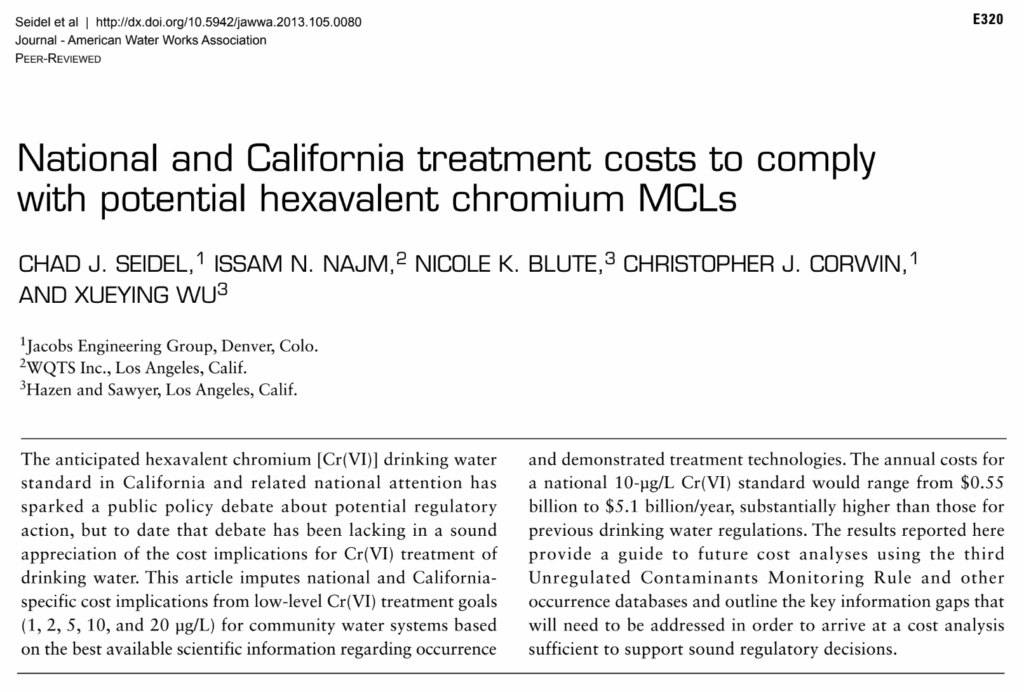
Abstract
Total and hexavalent chromium occurrence in the United States was investigated using three available datasets. The National Chromium and Boron Occurrence Survey, the US Environmental Protection Agency database of chromium from the Second Six-Year Review, and California Department of Public Health water quality analysis data were obtained and analyzed. The high number of nondetect samples and subsequent nondetect handling had an important effect on the determination of representative chromium concentrations. Chromium was found to occur widely throughout the United States. Total and hexavalent samples were paired, and they indicated that surface water speciation is dominated by trivalent chromium, whereas groundwater speciation is dominated by hexavalent chromium. The potential impact of further chromium regulation ranges more than two orders of magnitude, with as few as 1,000 entry points being affected nationwide at 20 μg/L and as many as 100,000 entry points being affected nationwide at 1 μg/L.
